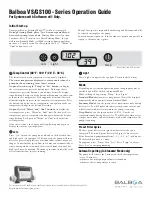
Heat Pump Water/Space Heaters
MWH/MWR models (c/w UC8) R32
Installation & Maintenance
CONTENTS
Page
1. General ................................................................ 1
2. Installation............................................................ 1
3. Wiring.................................................................. 2
4. Commissioning................................................... 4
5. Controls............................................................... 4
6. Maintenance....................................................... 5
7. Troubleshooting.................................................. 6
8. Warranty............................................................ 6
Table 1: UC8 Display Information........................ 8
Appendix I : BMS Control Option....................... 8
Appendix II : Protection Functions....................... 9
Commissioning Sheet .......................................... 11
Other Relevant Documents:
- MWH/MWR Applications Manual
- Specifications Sheet (model specific)
- R32 Handling : Water Heating Units
- MWH 900 LAT Control User Guide.
1. GENERAL
1.1 Introduction
Follow these instructions to ensure the optimum
performance, reliability and durability.
Units must be installed in accordance with all national and
regional regulations and bylaws.
National Health and Safety regulations must be followed
to avoid personal injuries.
The appropriate permits must be acquired and adhered to.
Seismic restraints must be fitted if required (refer NZS
4104:1994, AS 1170.4).
The accompanying 'R32 Handling' pamphlet forms part of
these Installation & Maintenance instructions.
!
WARNING.
These units use R32 refrigerant (Class A2L) which is
mildly flammable.
The unit shall be installed, operated and stored in a
adequately ventilated space (eg outdoors) where there is
no continuously operating open flames (eg an operating
gas appliance) or other R32 ignition source. If the
refrigerant gas comes into contact with fire, a poisonous
gas may occur. Be aware that R32 does not contain an
odour.
1.2 Site Preparation
System designers and installers must first familiarise
themselves with the contents of the MWH/MWR
Applications Manual prior to installing any unit. This
contains important information about site requirements
that will ensure the unit performs effectively and to
its design capabilities, eg expansion tank, water loop
pressure system.
2. INSTALLATION
2.1 Positioning
!
WARNING
The appliance should be located in an area where
leakage of the unit or connections will not result in
damage to the area adjacent to the appliance or to lower
floors of the structure. When such locations cannot be
avoided, it is recommended that a suitable drain pan,
adequately drained, be installed under the appliance.
!
WARNING
Keep appliance area clear and free from combustible
materials, gasoline and other flammable vapours and
liquids.
MWH/MWR units are designed to be located outdoors*
and as close to the space heating area as acoustic
criteria allows.
*
If the unit is located indoors, ensure adequate ventilation is
provided to maintain the internal air temperature no lower
than 5°C below the external ambient air temperature. It is
possible to duct the discharge air from the unit, however the
max. external static pressure is limited (refer Spec. Sheet).
It is recommended that an additional in-line fan be installed to
maintain airflow through the unit.
Refer to diagram (Figure 1) and supplied Specifications
sheet for minimum clearances. If multiple units are to be
placed side-by-side then allow at least 1m between coil
faces.
When determining the position of the unit, allow adequate
space around the unit to facilitate water pipe connections,
future servicing and maintenance. Ensure there is enough
working space in front of the electrical access panel.
Note: The discharge air from the unit is very cold when
the unit operates at full capacity, and may be well below
the freezing temperature. Take care in selecting the
installation position that the discharge air from the unit is
not under a window or plants that are cold sensitive. It is
also possible to get increased condensation on surfaces
above the unit discharge air which may deteriorate some
surfaces. Avoid installations where ponding of chilled air
is likely to occur. Choose a well-ventilated location.
Consideration should be given to the piping route to the
Room fan coil unit/s as well as power and control cabling.
Refer Specification Sheet for maximum separation limits
between MWH units and connected heat exchangers.
003-000-172
06
/22
GENERAL
INST
ALLA
TION
PRELIMINAR
Y






























